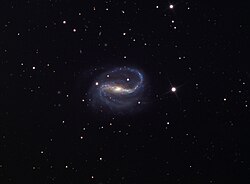Caldwell 44
The Propeller galaxy is an interesting subject for several other reasons as well. Hidden within the galaxy’s core lurks a supermassive black hole that feeds on large quantities of gas. The galaxy has also been the home to two recent supernovae, one witnessed in 1990 and the other in 2009. Supernova explosions blast stellar material back into the cosmos to be used in subsequent generations of stars. The Propeller galaxy is making rapid use of this recycled material as it undergoes starburst activity, with many bright, young stars peeking out of the spiral arms and disk. The three brightest stars in this image, however, are foreground stars — caught on camera because they lie between us and the galaxy.
This image was taken in visible and infrared light with Hubble’s Advanced Camera for Surveys. The observations were taken to study the galaxy’s most recent supernova, SN 2009jf. Astronomers have also used Hubble to investigate star formation in Caldwell 44.
Discovered by astronomer William Herschel in 1784, the Propeller galaxy can be found in the constellation Pegasus. However, at a distance of 110 million light-years from Earth, this magnitude-10.8 galaxy is hidden from the naked eye. Use a medium to large telescope to look for Caldwell 44 in autumn night skies from the Northern Hemisphere, or in spring skies from the Southern Hemisphere.
For more information about Hubble’s observations of Caldwell 44, see:
www.spacetelescope.org/images/potw1125a/
Credit: ESA/Hubble & NASA
For Hubble's Caldwell catalog site and information on how to find these objects in the night sky, visit:
www.nasa.gov/content/goddard/hubble-s-caldwell-catalogRelevantní obrázky
Relevantní články
NGC 7479NGC 7479 je spirální galaxie s příčkou v souhvězdí Pegase vzdálená přibližně 112 milionů světelných let. Objevil ji britský astronom William Herschel v roce 1784. Na obloze se nachází ve vzdálenosti 3 stupňů směrem na jih od hvězdy Markab (α Peg) s magnitudou 2,5. .. pokračovat ve čtení



